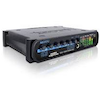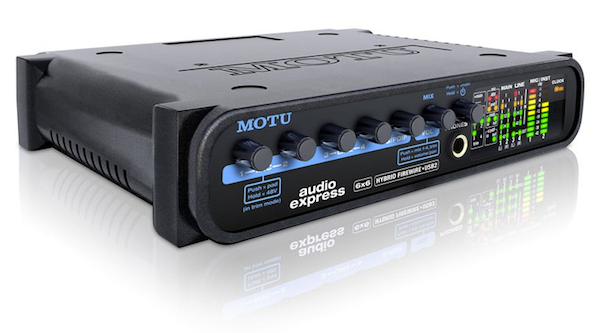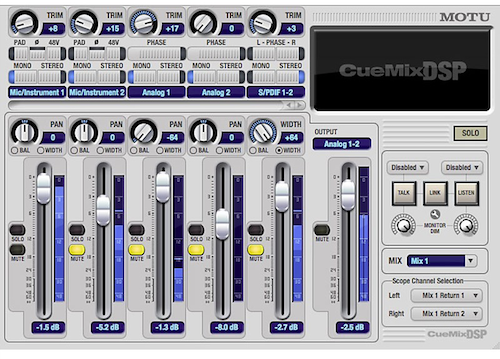MOTU AUDIO EXPRESS REVIEW
Posted on Mon 21 March 2011 in entries
 When MOTU began designing their latest product, they state that they had one goal in mind… to design the ULTIMATE personal studio interface! That’s not to say that the idea was to create something that cost a bomb and could do absolutely everything… the intended outcome was to build a product that was perfect for the small home studio, was housed in a simple box, was easy to use, and was within the price reach of us mere mortals… and what the MOTU team came up with was the fantastically competitive Audio Express…
When MOTU began designing their latest product, they state that they had one goal in mind… to design the ULTIMATE personal studio interface! That’s not to say that the idea was to create something that cost a bomb and could do absolutely everything… the intended outcome was to build a product that was perfect for the small home studio, was housed in a simple box, was easy to use, and was within the price reach of us mere mortals… and what the MOTU team came up with was the fantastically competitive Audio Express…
MOTU AUDIO EXPRESS – IN THE STUDIO
First and foremost, the MOTU Audio Express is a flexible audio/MIDI interface. It features hybrid connectivity, meaning it can connect to a Mac or PC using either Firewire (400 Mbit per second) or high speed USB 2.0 (480 Mbit per second). It’s worth noting that if your computer only features Firewire 800 connections, then fear not, as you can easily purchase a cable to cater for this situation (click here for an example - different lengths available). This connection deals with all audio and MIDI data transfer between your computer and the MOTU Audio Express and can also be used to power the interface so that you don’t have to use an additional power socket!
 ](https://www.absolutemusic.co.uk/motu-audio-express-firewireusb-20-audio-interface.html)
](https://www.absolutemusic.co.uk/motu-audio-express-firewireusb-20-audio-interface.html)
Once you have the MOTU Audio Express hooked up to your computer it is then a simple task to set up for a recording scenario. Firstly the MOTU Audio Express features 2 mic/instrument inputs with pristine preamps (and high-impedance load characteristic on the guitar jack connection, suitable for both passive and active pickups), which should be enough for the average home/bedroom studio. This combination will allow you to plug in combinations such as a microphone and a guitar, or a lead guitar and a bass guitar, or 2 microphones, etc.
If you are planning on working with more complex set-ups then you will obviously want to look at something with more inputs than the MOTU Audio Express, although if you don’t have the money, you always have the option of recording more tracks over existing ones at a later point in time. For example, you may record a lead guitar and a bass guitar together, then once they have been recorded, route both tracks back to a vocalist's headphones so that they can listen to the previous guitar recordings whilst they record lyrics. For this reason, the only situation I can think of where you may desperately require more inputs is if you are recording a fully mic’d drum kit, but I doubt too many bedroom producers will be doing that in their own home!
Both of these inputs offer individually selectable -20dB pads for when you are recording at very high signal levels, and switchable phantom power for use with condenser microphones.
In addition to the two microphone/instrument inputs, the MOTU Audio Express also offers 2 line inputs (ideal for connecting an instrument such as a synthesiser), and a 24 bit/96kHz S/PDIF input, and what’s really great about the interface is that each of these inputs has a dedicated level control on the front panel! This means that it is exceptionally quick and easy to make balance adjustments between the levels of each input, and you can also use the master volume dial to control the overall output without affecting the balance between all the individual inputs. The MOTU Audio Express interface makes use of digitally controlled analogue trim technology, meaning that it gives you the clean, pure sound of traditional analogue, with the precision of digital control!
 ](https://www.absolutemusic.co.uk/motu-audio-express-firewireusb-20-audio-interface.html)
](https://www.absolutemusic.co.uk/motu-audio-express-firewireusb-20-audio-interface.html)
Ok, so we’ve dealt with getting signals into the MOTU Audio Express, but what about feeding them out? Luckily the MOTU Audio Express interface is fully equipped in this area as well! It features stereo main jack outputs to hook up your main monitors, plus a second pair of stereo line outs (useful if you want to hook up a secondary pair of reference monitors), and a S/PDIF output to route your audio to a device such as a home stereo (for a third pair of reference monitors, or to make a recording in a different way), and you can mix, match and switch between each output as required. And of course, the MOTU Audio Express also features MIDI In and Out connectors (with sample-accurate timing) for applications such as connecting a MIDI controller to your system, and there is also a headphone socket for monitoring your mix through a pair of cans! Plus, if you are feeling a bit flash, the MOTU Audio Express interface even features a connection for a standard momentary footswitch, so you can perform hands-free punch-ins during recording, or map it to any keystrokes that you wish using the host audio software!
It may also be worth mentioning that you don’t need to boot up your computer to use the MOTU Audio Express. If you plug it in to a socket using the DC power connection, then the interface will continue to serve as a studio mixer! So for example, you can record to a device using the S/PDIF output, or simply play your instrument though a pair of studio monitors without even turning your computer on! And you can still control the level of each input using the immediate controls on the front of the interface!
MOTU AUDIO EXPRESS – LIVE MIXER
One of the real appeals of the MOTU Audio Express is that despite being of a modest size, it is equally at home on the road as it is in the studio. In this situation you may choose to hook up a pair of powerful active PA speakers to the main outputs of the Audio Express, a pair of PA monitor speakers for the performer (or a second pair of main speakers) to the line outs, a microphone and guitar to the Mic/Inst inputs, an in-ear monitoring system (for the performer) to the headphone socket, a synthesiser to the line-inputs, and recording device to the S/PDIF output – again you don’t even need your computer so the MOTU Audio Express is a fantastic portable solution!
As before, just use the controls on the front of the panel to control all the mix busses, with direct access to volume, mute and solo for each input. This also has advantages in that monitoring through software can introduce latency on your track, so by doing all your mixing directly from the Audio Express, you completely eliminate this issue! You can even control the stereo pan by holding the mix volume button! I’m not saying this thing is ever going to provide an alternative to a proper mixing desk if you are a serious club sound engineer! But if you are for example, a solo guitarist and vocalist, the MOTU Audio Express would be a brilliant portable mixer to get quickly set up with and balance your levels for a performance.
 ](https://www.absolutemusic.co.uk/motu-audio-express-firewireusb-20-audio-interface.html)
](https://www.absolutemusic.co.uk/motu-audio-express-firewireusb-20-audio-interface.html)
MOTU AUDIO EXPRESS – CLOCKING
Ok, I have a little confession to make about this next section… I basically just took all the text straight from the MOTU website! I couldn’t really think of a way to jazz up information on time code synchronisation, and despite being a useful feature, and one that I felt would be good to inform you on, it’s one of those subjects that is a little boring to talk about! Hence I hope you can forgive my brain for partially giving up when it came to writing this section! There, I have confessed my sin! Please forgive me, it shall not happen again!
The MOTU Audio Express features SMPTE time code sync, so you can resolve the Audio Express directly to SMPTE time code without a dedicated synchroniser, via any analogue input! The Audio Express also provides a DSP driven phase-lock engine with sophisticated filtering that provides fast lock-up times and sub-frame accuracy. This technology represents the very latest in amazing high-performance, yet cost effective digital audio clocking! What’s more, is that the MOTU Audio Express allows the interface to maintain an extremely stable clock whilst connected to an incoming clock source that has substantially more jitter than the Audio Express itself!
The MOTU Audio Express even comes with MOTU SMPTE console software (for Mac OS X and Windows), which gives you all the tools to generate SMPTE for striping, regenerating, or slaving other devices to your computer. This software can be very useful, and can massively speed up such tasks.
MOTU AUDIO EXPRESS – COMPATIBILITY
The MOTU Audio Express works with most popular music and pro-audio applications on both Mac OS X and Windows platforms, so you shouldn’t have a problem integrating this interface into your current set-up. Logic, Cubase, Pro Tools 9, Live, Reason, Record, Digital Performer, Sonar, Nuendo, FL Studio, plus loads more – the MOTU Audio Express is compatible with them all! For a full list of compatible software click here to go to the MOTU Audio Express official webpage.
MOTU AUDIO EXPRESS – SOFTWARE
The MOTU Audio Express comes with plenty of included software to ensure your projects always reach their full potential. CueMix FX gives you full graphic control over your mix and other settings in the Audio Express, with up to 4 separate stereo mixes (corresponding to each output pair – main, line, S/PDIF and headphones) and it can be used in conjunction with any host audio software (on both Mac OS X and Windows), and can even be controlled with a Mackie Universal Pro controller! The software even includes an instrument tuner, oscilloscope, FFT/spectrogram, and phase analysis tools, to ensure that you always get the best out of your mixes.
 ](https://www.absolutemusic.co.uk/motu-audio-express-firewireusb-20-audio-interface.html)
](https://www.absolutemusic.co.uk/motu-audio-express-firewireusb-20-audio-interface.html)
On top of all this, the MOTU Audio Express also comes with AudioDesk software, which provides a complete software workstation for recording, editing, mixing, processing, and mastering! It is basically a piece of DAW software, so you don’t actually need to make any additional software purchases to produce a professional project with the MOTU Audio Express! However, please note that the AudioDesk software is for Mac OS X ONLY! Sorry Windows people!
MOTU AUDIO EXPRESS – SUMMARY
I use a MOTU interface in my home studio (the Traveler Mk3 to be precise) and would certainly recommend their products. In fact, the Audio Express has a similar design to the Traveler, it is just less feature-rich and as such employs a more compact case. But why would you choose to buy a MOTU Audio Express over a product in a similar price range?
Well, it’s a quality piece of kit for starters and it’s ease of use combined with it’s flexibility as both a studio interface and live mixer make it an appealing product. I also love the detailed LED feedback that the MOTU Audio Express gives, letting you monitor main, line, and mic/inst levels, along with displaying the statuses of your clock sample rate, trim, phantom power, pad, S/PDIF, and MIDI settings!
I guess another product that I would recommend in a similar price range would be the Focusrite Saffire Pro 40. It’s slightly more expensive than the MOTU Audio Express, but it does offer a massive 20 mono inputs and 20 mono outputs, so does give you increased flexibility in this respect, which is brilliant for recording more instruments. If you feel that you will need this amount of inputs and outputs, then obviously I would recommend that you choose the Focusrite over the MOTU!
However, there is little point in wasting money and desk/rack space on features that you are never going to use, so if your projects don’t require such vast connectivity, then the simple and easy-to-use interface of the MOTU Audio Express (which admittedly does possess superior converters to the Saffire Pro 40) will be perfect for you! After all, what’s the point of having an interface with loads of controls and dials that you are never going to use?
In addition, the Audio Express' more compact design makes it great for taking along to live performances, and it also has an advantage over the Focusrite in that it offers USB 2.0 connectivity – it is not just a Firewire interface! Plus, if you mainly work with Mic/Instrument, Line, and S/PDIF combo set-ups, then the MOTU gives you immediate level controls for each of these inputs on the front panel... the Saffire Pro 40, due to its increased capabilities, is not quite as simple.
If you are considering purchasing an interface it is definitely worth doing some serious research to discover which will suit your needs best. There are plenty of others out there as well and my words are only intended for general guidelines - the best interface for one person may not be the best for another!
However, if you do purchase the MOTU Audio Express and find that your needs grow in the future, then the interface allows you to connect another Audio Express (or other MOTU interface) to your existing unit via a standard Firewire or USB 2.0 hub to extend the number of available inputs and outputs! If you decide to do this, the MOTU Audio Express provides driver-level support to ensure that audio streams from multiple interface’s never drift apart, so it’s absolutely no problem at all to expand your equipment as your needs grow.
Right, I’ve probably waffled on for long enough now! I hope you found this article informative, but if you have any questions, feel free to leave a comment below and I will do my best to help you out!
For more information on the MOTU Audio Express click the link below or give us a call on 01202 597180
MOTU Audio Express - More Info/Buy
******If you're interested in buying and you have seen it cheaper elsewhere, please call us or use our
As well as receiving our first rate customer service you can also claim money off your next purchase with our loyalty points scheme and receive a 3 year warranty if you sign up to our FREE VIP Club (click here for more infomation). Many of our items also come out on a FREE next-day delivery service to mainland UK customers, so you won't be left waiting!
Also, if you want to keep up with all our latest offers, competitions, news and videos, why not follow us on Facebook and Twitter?
